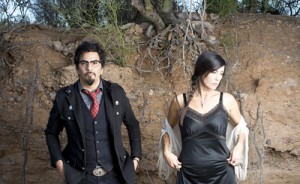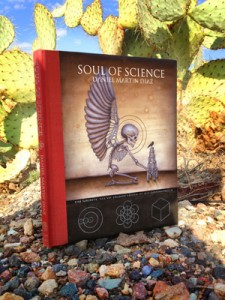Sacred Machine: Creation, Evolution & Moving On

Daniel Martin Diaz and Paula Catherine Valencia, in a photo for their band Crystal Radio.
photo: Danni Valdez
It’s easy to get deep with Daniel Martin Diaz and Paula Catherine Valencia. Diaz’s art and Valencia’s writing—plus their music with Blind Divine and Crystal Radio—dig into the heart of the mysteries of existence. One cannot look at Diaz’s work without feeling pulled into a rabbit hole of esoteric human inquiries; his pieces—especially in his recent book Soul of Science—are individual time machines of ancient knowledge and futuristic anomalies of biology and technology; amalgams of religion, science, mythology and psychology. The detail is exquisitely intricate, the edgy motifs are fascinating and possibly daunting to the unadventurous or religiously sensitive.
For Diaz, creating is about letting the art and music “take me where it wants to take me. Really, you’re just a vessel for the art or the music that you are creating, it’s like you are sculpting something. It’s manipulating you as opposed to you manipulating it. I think also, creating art or creating music and not really fully understanding what you’re doing is part of the mystery.
“I’ve always approached music and art (that way)—always trying to find the mystery that is hidden there, but then not truly understanding what it is. And I think that’s what keeps me motivated enough to keep going and keep finding this mystery because, for myself, this is what’s worked. If I understand what I’m doing, then the magic and the mystery is gone. And then it’s like, what’s the point of going on anymore creating?”

Soul of Science is Daniel Martin Diaz’s latest book collection of art.
photo courtesy Mysticus Publishing
Opening himself as a vessel for the music and art has proven very successful. Diaz, a 47-year-old native Tucsonan, has been extremely prolific during his career, which has included: a 200-song catalogue (collaborations done with Paula and others) with tracks utilized by over 30 major television outlets, national and international art exhibits, album and book covers, four personal publications of his work, and a list of public art commissions.
The most recognizable of Diaz’s public art projects in Downtown Tucson are: Club Congress’ Proscenium Stage, Hotel Congress’ terrazzo floor and the metal work on the Plaza Centro parking garage, 345 E. Congress St. at 4th Avenue. While the process of creating public art is different from his personal work, there are still similarities.
Wife and creative/business partner Valencia explains: “We have to work within parameters, so, you’re given this set of rules to work within, and then it becomes kind of free form. Half the things that we do are sitting somewhere in a restaurant, done on a napkin, especially with public art. ‘Ok, here’s the concept, this would be really cool.’ And then maybe Daniel starts sketching stuff and I start writing the concepts and themes behind it. In our folders, we always have these napkins stuck behind the paperwork and the contracts. So, a lot of times it’s a free form type of thing too and then it gets developed from there, then working with architects and all the intricacies, putting that into the large work.”
“A lot of research goes into public art,” Diaz adds. “We research the area, research the community, research who’s lived there–like in the 1880s, 1700s–and look at the wildlife and what has been here in this area that we can use as a resource for the art. I think that’s a different approach than I do with my own work, but I really like it.”
The couple explains that the work integrated into the Plaza Centro garage, called Desert Splendor, includes inspiration from the desert, the trains, the railroad tracks and artistic patterning from local Native cultures, all placed to incorporate the sun’s movement for specific effect.
“If you look at that design, one side of it has a tree with leaves and the other side has a tree without leaves, so it’s this idea, because the sun hits one side of it and it changes throughout the day, so it’s this idea that ‘Change is now occurring,’” Diaz explains, “with the seasons and even just the change within a day that we go through. Downtown changes from morning to sunset.”
For Daniel and Paula, their own changes are occurring. At the end of May, after a four year run, the couple is closing their museum/gallery/curio shop Sacred Machine, 245 E. Congress St., and moving to Los Angeles in the fall.
The decision to open the space in May 2010 wasn’t premeditated, they explain. “It was one of those things he was talking about with his art,” Paula says. “It really chose us, this space. We were sitting in here for a meeting… and I’m like, ‘We need this space.’ It was really strange; he thought I was insane, and I said, ‘Well maybe I am, but this space is calling out to me for whatever reason’.”
At the time, their neighbors on the block included Xoom Juice, Yoga Oasis and Cricket Wireless. Businesses across the street (Tooley’s Cafe, 276 Works Gallery, Central Arts Gallery, Preen, Rocket Gallery, Dinnerware ArtSpace and Metropolis The Salon) had been displaced for what wouldn’t become An Congress (now Playground, Pizzaria Bianco and HUB), though the night club Sharks (now Saint House) was still operating; The District Tavern was and is still pouring drinks. The couple has witnessed Downtown’s evolution (see related story here), and has had a great run with Sacred Machine—hosting compelling art exhibits and live music in addition to meeting interesting artists, musicians, getting to know other merchants and the public at large.
“We had one of the producers of The Simpsons come in here, and Paula became really good friends with her and,” Diaz continues, “we became good friends with Alex Maas from The Black Angels, because of the gallery. In L.A., I think those opportunities are going to be intensified. We’ve been here our whole lives, so we’re ready to move.”
“We’ve been creating (in Tucson) for 24 years now, since we’re met, and raised our son,” Paula says. “Damian is 21 (now), so, let’s go explore! We’re doing art, music, public art, we’re doing all these things, and really, we can move any where and do those things. It’s kind of–have art, will travel. Let’s go do this there, and we’ll do that, and maybe we’ll end up in Paris one day.”
“We’ll give it a shot and see what happens,” Diaz adds. “We have no—like in everything we do—we don’t have expectations. I just feel like when you have expectations, you are setting yourself up for some kind of failure. Just go over there, see what happens. And, if we’re there for 10 years, if we’re there for 20 years, great, if not, we could end up in Paris, with Sacred Machine over there, great. We just don’t know. That’s been our life. We wake up and we don’t know what that day is going to bring, and that’s good and how we want to live.”
Sacred Machine’s May events include the 1st Saturday Art Walk on May 3, 4 p.m.-9 p.m. The farewell celebration is from 5 p.m.-10 p.m. during 2nd Saturdays on May 10; the “Blue Print for the Future” exhibit opens May 10 and runs through May 31. Closing day hours on May 31 are noon-9 p.m. Regular hours are 5 p.m.-8 p.m. Wednesday-Friday and 4 p.m.-9 p.m. Saturday. Keep abreast of their adventures at SacredMachine.com and DanielMartinDiaz.com.
Category: Arts, Business, Community, DOWNTOWN / UNIVERSITY / 4TH AVE




